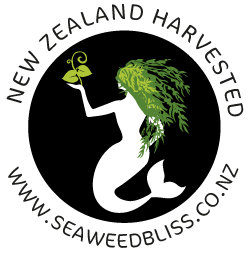|
|
New Zealand has a complex ocean topography with 3 major currents mixing to create ideal conditions for seaweed growth. The Wairarapa coastline with its hard rocky substrates and variations in sediment, benefits from the mixing of cool, nutrient rich subantartic waters with the warm, nutrient-poor subtropical waters.
The resulting strong physical and nutrient gradients provide for a bountiful marine ecosytem. Seaweed on the sea floor provides a valuabe source of nourishment for aquatic dwellers as well as offering shelter and habitat for many smaller speciies of marine life.
The Wairarapa is know for its crayfish and paua and a miriad of wet fish species as well as the large quanties of seaweed that is beach cast after large southerly swells.

Green Seaweed
Incredibly there are around 140 species of green seaweed recorded in New
Zealand. Typically found in shallow water where there is plenty of
sunlight, the most striking and common of the green seaweeds is the
edible sea lettuce. When large quantities of sea lettuce are washed
ashore, the smell can be considered offensive to some as rot sets in.

Brown Seaweed
Brown seaweeds are the type of seaweed most commonly seen on our coast. Bull Kelp (Durvillaea sp) is the most commonly known brown seaweed. Large beds appear to "dance" in the waves and it is characterised by it's large size and chains of water-filled sacks. Poha or kelp storage bags can be made from the bull kelps, Durvillae antartica and D. poha. They were used by early Maori to store water and plant and fish oils for long voyages. In the southern South Island and Stewart Island/Rakiura the giant kelps have traditionally been used for preserving and storing salted or cooked titi (sooty shearwater or muttonbirds). A range of brown seaweeds are collected as a source of alginates and as fertiliser and animal feed.

Red Seaweed
Porphyra and Pyropia species of red seaweeds are a very rich source of protein, minerals and vitamins. Used for hundreds of years in Asia and highly prized in New Zealand by Maori where it is know as karengo . With its cellophane appearance it resembles Japanese nori. Maori traditionally used some seaweed species to supplement their diet. Karengo, pulled from tidal rocks in winter and spring was usually dried before use and supplemented the winter diet because of its high nutritional value.
Collecting for Seaweed Bliss
The Wairarapa coastline with its jagged rocks and pounding surf is the ideal North Island location for beach cast seaweed collection.
Beach cast seaweed is a glorious mixture of the many species found on the Wairarapa coast. While seasonal variations will occur our brew is likely to contacin some or all of the following species:
Ulva rigida, Ulva spatulata, Ulva laetevirens, Enteromorpha flexuosa, Cladaphora daviesii,Ecklonia radiata, Ecklonia brevites, Sargassum sinclarii, Carpophyllum angustifolium, Cystophora retroflexa ,Cystophora torulosa, Gigartina decipiens, Gigartina macrocarpa, Gigartina atropurpurea, Rhodophyllis gunnii, Euptiloca formosissima, Ballia Callitricha
Our team collect seaweed species that combine to create our high-performing Seaweed Bliss plant tonic and ensure sustainability of the coastline at the same time.
Information Sources: Wendy Nelson and Maggy Wasselieff

